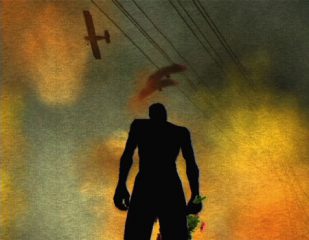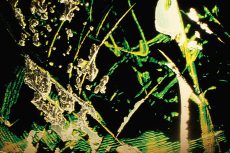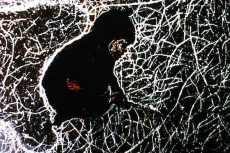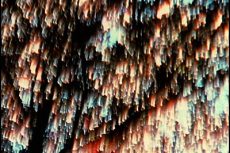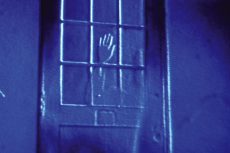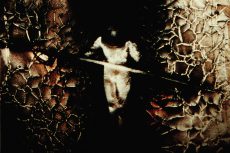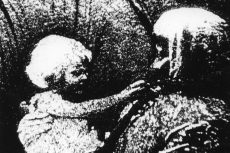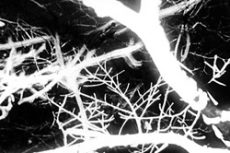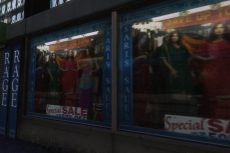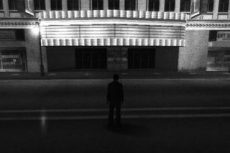“Twilight Made Manifest: The Films of Phil Solomon.” June 25-28, 2015
Twilight Made Manifest: The Films of Phil Solomon
Three program retrospective. Phil Solomon in person.
“A longing for a transcendental experience, for Mystery, is absolutely at the heart of filmmaking for me.”—Phil Solomon
“Lens manufacturers, Kodak, the entire industry, have worked toward making the cinematic reproduction of life more and more real, in a surface sense. I’m something of an archaeologist in reverse: I try to discover truths in these artifacts by throwing the dirt back on them. I bury things rather than excavate them. For me, found footage has always been a way to unearth lost truths.” —Phil Solomon
“Plots stir just beneath the thresholds of perceptibility. The sea swells of these subliminal stories align images into meaningful rides but often indecipherable configurations. [Solomon’s] films invite the reader/detective to pursue the thread of narrative, but no closure is promised, no final answer lies behind the veil.” —Tom Gunning
The significance of American filmmaker Phil Solomon’s body of work over the past thirty years is amplified by the artist’s mastery of imagery that truly straddles the film/digital divide. In his early work, Solomon favoured intricate artisanal methods, subjecting found footage to high degrees of chemical processing and optically printing the results with lighting setups that highlighted the three-dimensional cracks and fissures of the distressed emulsion. In this, Solomon evinced an aesthetic interest in visual abstraction that he shared with his mentor and occasional collaborator Stan Brakhage, but he combined it with a sophisticated use of found material. Unlike many found-footage filmmakers, who used the viewer’s recognition of the material as a vehicle for irony, Solomon melted his imagery into intricate, slowly unfolding atmospheres that carried a deep emotional resonance. Solomon achieved his culmination of this style in The Twilight Psalms, a continuing series of films that uses The Twilight Zone as a loose structural guide to mysteriously evoke the dark undercurrents of the twentieth century.
This approach shifted significantly in 2005, when Solomon introduced his friend, filmmaker Mark LaPore, to the immersive videogame world of Grand Theft Auto. In one intensely productive evening, the two artists explored the environment like location scouts, and used their digital wanderings to create Crossroad, a collaborative tribute video to their colleague David Gatten, who at the time was suffering from a serious illness (which he later recovered from). When LaPore himself tragically died soon after the completion of Crossroad, Solomon created a trio of videos, collectively titled In Memoriam—consisting of Rehearsals for Retirement, Last Days in a Lonely Place, and Still Raining, Still Dreaming—that used the landscape of GTA as the visual source material.
While this imagistic shift came as a complete surprise to those familiar with the artist’s work, Solomon’s deft cinematic phrasing is still very much in evidence here. His faith in the environment as a fitting tribute to LaPore is vindicated over the course of the cycle, as the films resonate with an energy akin to that of the edgy, dystopian ethnographic explorations found in LaPore’s own work. (The parallels between Still Raining, Still Dreaming and LaPore’s The Sleepers is especially uncanny.) Surprisingly for an artist so adept with the optical printer, Solomon fully embraced the underappreciated dexterity needed to détourne a videogame towards his cinematic needs, and his current work has shown him as much at home in this vectored contemporary landscape as he had been amongst the chemical inducements of the past.
The shadow of death hangs over much of Solomon’s work. Early films like The Exquisite Hour and Remains to Be Seen meditate on the loss of his parents, while Seasons…, his late collaboration with Stan Brakhage, has mortality inscribed in its very method: Brakhage made the film by carving into the emulsion, as he had been forced to abandon his previous painting-on-film technique because the coal-tar dye of the paints he used had been a contributing factor to his eventually terminal cancer. On a larger canvas, The Twilight Psalms and the three-channel installation American Falls speak to the deep fissures of the twentieth century and, especially in the latter, the decline of the United States.
However, Solomon finds a resonant beauty in these shadows. (And in fact, his chemical processes themselves—which make imagery appear to rise from the projected surface as if embossed—rely on shadow, activating the silver halides that create darkness in the film frame.) In both their physical being and experiential form, Solomon’s films find that place where the elegiac becomes the ecstatic, pushing the cinema forward towards an ultimate, unyielding sublime. —Chris Kennedy
Still: Crossroad
- Seasons…
- The Snowman
- The Secret Garden
Early Work & Collaborations
From its very beginning in the early 1980s, Solomon’s work displayed a distinctive style that garnered attention. Tom Gunning grouped him with some of his contemporaries (including Lewis Klahr, Peggy Ahwesh, and Mark LaPore) in an essay titled “Towards a Minor Cinema,” which acknowledged these artists’ turn away from the romantic ego of psychodrama (à la Stan Brakhage), the conceptualism of structural film (à la Michael Snow), and the political theory of New Narrative (à la Yvonne Rainer) to a more expressive lyricism of image and montage. Solomon’s reanimation of found footage was central to this break; in particular, The Secret Garden (which Gunning describes as a “sensual festival of color”) demonstrated how an artist could harvest footage from unlikely sources (here, the 1949 Hollywood film of the title, as well as The Wizard of Oz) in order to create a new form of storytelling. This preternatural blend of imagery finds earlier precedents in What’s Out Tonight is Lost (recently restored by the Academy Film Archive) and the moving The Exquisite Hour.
While Gunning’s essay located Solomon on the other side of a generational divide from his experimental-film forebears, a teaching appointment in Boulder, Colorado found Solomon lecturing alongside Brakhage. Solomon’s technical assistance to the older artist in optically printing Brakhage’s hand-painted work quickly led to a fruitful collaboration, and the two subsequently worked on a few film projects together, including one of Brakhage’s last works, the beautiful and evocative Seasons….
What’s Out Tonight is Lost dir. Phil Solomon | USA 1983 | 8 min. 16mm
Crossroad dirs. Phil Solomon & Mark LaPore | USA 2005 | 5 min. video
The Exquisite Hour dir. Phil Solomon | USA 1989/1994 | 14 min. super 8 on 16mm
The Secret Garden dir. Phil Solomon | USA 1988 | 17 min. 16mm
Seasons… dirs. Phil Solomon & Stan Brakhage | USA 2002 | 18 min. 16mm
The Snowman dir. Phil Solomon | USA 1995 | 8 min. 16mm
Thursday, June 25 6:30pm
- Twilight Psalms I: The Lateness of the Hour
- Twilight Psalms II: Walking Distance
- Twilight Psalms III: Night of the Meek
The Twilight Psalms
Its name a play on that of The Twilight Zone (and with each of its individual installments adopting the title of an episode from the television series), the ongoing Twilight Psalms is the centrepiece of Solomon’s oeuvre. Emulating the creeping unease of its almost-namesake and evoking a plaintive millennial regret, this series of films goes beyond personal narrative to address the failings of history, looking back at the pains (and horrors) of the twentieth century and directing a so-called “minor” cinema towards grander gestures and a more expansive conceptual ambition. The Psalms also showcases some of Solomon’s most stunning employments of optical printing, particularly in the two central films Walking Distance (which uses footage of Harry Houdini to evoke the physical difficulty of escape) and Night of the Meek (which links imagery from Paul Wegener’s The Golem and James Whale’s Frankenstein to the industrial-scale pogrom of the Holocaust); the bronzed and embossed figures in the former and the black-and-white decay of the latter are some of the most visually compelling images created during the century’s turn. Our screening of The Twilight Psalms is preceded by Stan Brakhage’s First Hymn to the Night – Novalis, which was made in the period immediately preceding his collaborations with Solomon.
First Hymn to the Night – Novalis dir. Stan Brakhage | USA 1994 | 3 min. 16mm
Psalm I: “The Lateness of the Hour” dir. Phil Solomon | USA 1999 | 10 min. 16mm
Psalm II: “Walking Distance” dir. Phil Solomon | USA 1999 | 23 min. 16mm
Psalm III: “Night of the Meek” dir. Phil Solomon | USA 2002 | 23 min. 16mm
Psalm IV: “Valley of the Shadow” dir. Phil Solomon | USA 2013 | 8 min. video
Saturday, June 27 1:00pm
- Nocturne
- Still Raining, Still Dreaming
- Last Days in a Lonely Place
In Memoriam
“Do you think the end of the world will come at night time?” “Uh-uh. At dawn.”—Rebel Without a Cause
One of Solomon’s earliest films, Nocturne uses time exposure to capture the lightplay of darkest night. The lights and shadows of the neighbourhood around Solomon’s home are blended with footage of air raids from World War II, creating a disturbing yet compelling vision of suburban anxiety and the historical memories that haunt the night. This nocturnal unease returns in the In Memoriam trilogy—made in response to the death of Solomon’s lifelong friend Mark LaPore—where Solomon guides us through the dystopic hinterlands of Grand Theft Auto to find uncannily affecting landscapes that speak to loss, solitude, and departure. The programme concludes with one of Solomon’s most stunning films, Remains to Be Seen, a memorial to the artist’s mother that chemically transforms found images (of a ghostly cyclist, surgeons around an operating table, and others) to create haunting visions of a life once lived.
Nocturne dir. Phil Solomon | USA 1980 | 8 min. 16mm
Rehearsals for Retirement dir. Phil Solomon | USA 2007 | 11 min. video
Last Days in a Lonely Place dir. Phil Solomon | USA 2007 | 20 min. video
Still Raining, Still Dreaming dir. Phil Solomon | USA 2008 | 12 min. video
Remains to Be Seen dir. Phil Solomon | USA 1989/1994 | 18 min. super 8 on 16mm
Sunday, June 28 8:00pm
Phil Solomon’s Empire x 8 was installed concurrently at the Ryerson Image Centre from April 29 – June 28, 2015.
